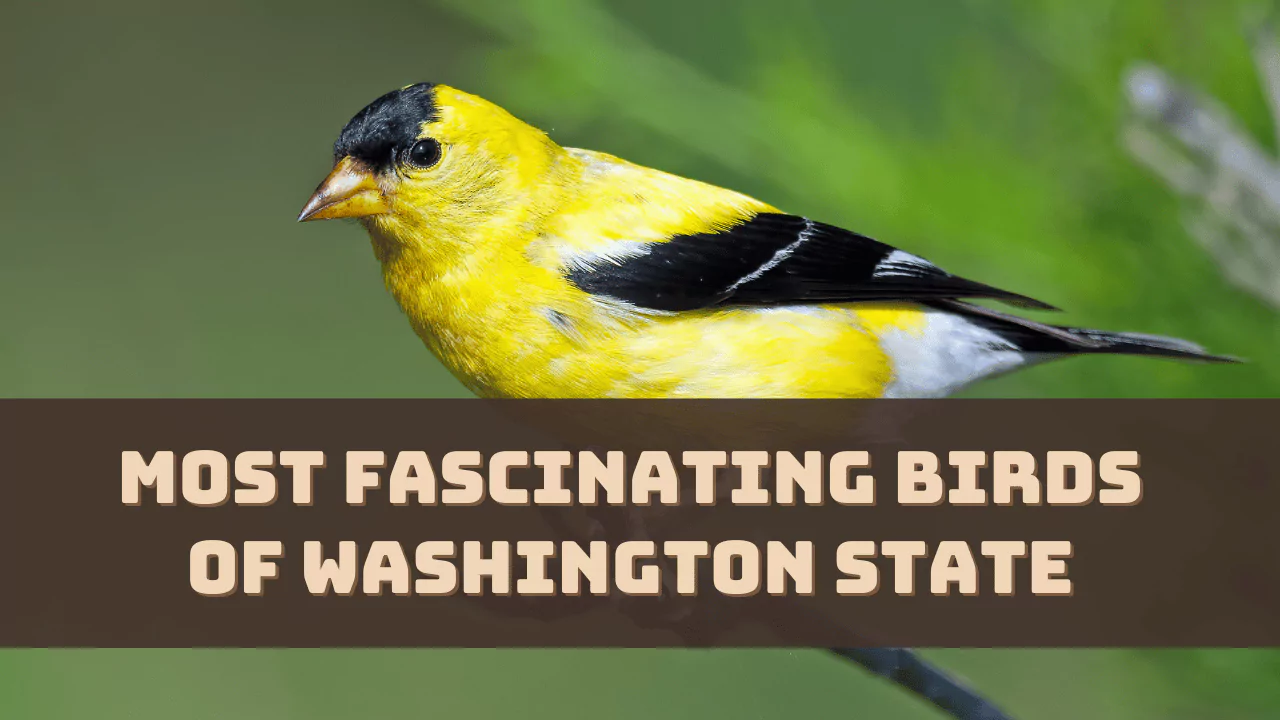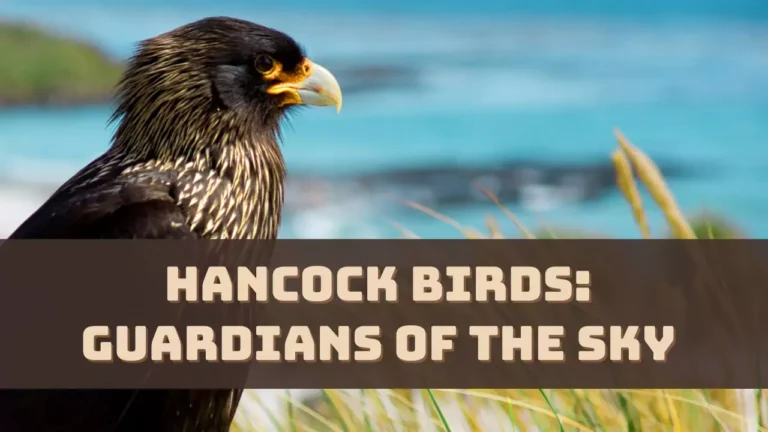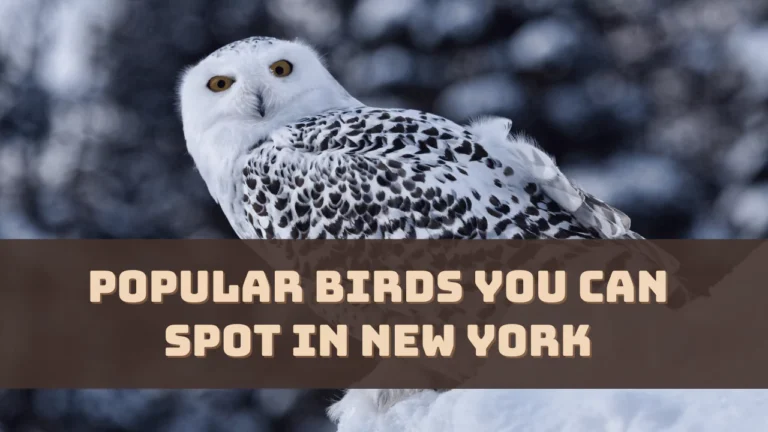You will find more than 508 varieties of bird species in Washington, as this place has a rich and diverse habitat, including rocky mountains, a coast range, and lowlands. The most popular birds you can come across are the American Robin and the Bank Swallow. so, if you are eager to visit this place, this is indeed a birdwatcher’s paradise.
Thus, to make it easier, we have listed the 15 common birds, their appearance, and where you can spot them more often. This guide will help you to locate the birds based on their size and feeding behavior as well.
American Goldfinch
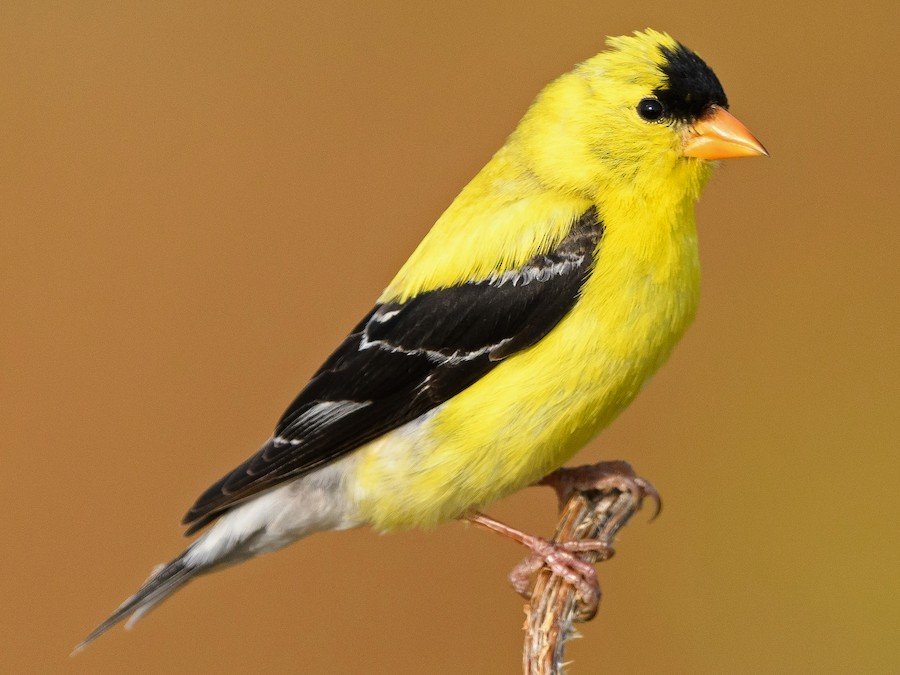
American Goldfinch is also a native bird of North America and they can be distinguished from their yellow backside and black wings, where white bars can be seen on the wings. There are also white markings on the short tail. They have a white underside rump and yellow underside with a black cap on the forehead. They have medium-sized, conical and orange-colored beaks, the females can be distinguished from the males due to their olive color and the yellows are quite dull.
These birds are 4.5 inches in length and weigh 0.4 to 0.6 ounces in weight. They can be easily spotted in meadows, gardens and fields.
They feed on different variants of seeds such as thistle and sunflower and also eat berries, nectar and insects. They are seen to build nests in trees and shrubs and, being social, can be spotted in large flocks.
European Starling
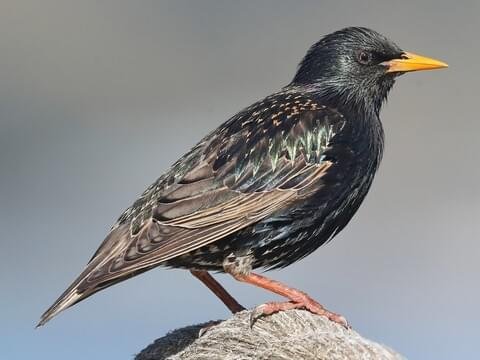
European Starling is generally found in Europe, Africa and Asia; they were introduced to North America in the 19th century. These medium-sized birds can also be found throughout the continent. The interesting fact is when they are far away, they appear to be black and when they are close they show a mixture of purple and green, which is their summer plumage. They also have long pointed wings and short tails. These birds have a large golden beak.
They are 7 to 8.5 inches long and 1 to 1.6 ounces in weight and they can be primarily spotted in forest, and urban areas.
They feed on insects, seeds, fruits and human garbage. They build their nest in tree cavities and being adaptable they can be spotted in large flocks.
Tricolored Blackbird
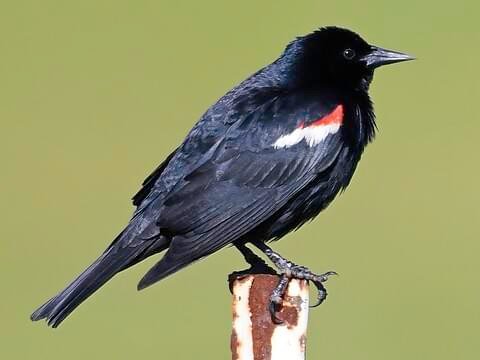
Tricolored Blackbird is found in North America and the male version is easier to identify due to its white and red color on the shoulder which also resembles the shark fins having red tips, with large wings. The females have longer notched black tails when compared to the males. These birds have dark-colored feathers with cream-colored brow lines and streaked bellies.
They have thick pointed medium-sized beaks, these birds are 7 to 8.5 inches long, weigh 0.7 to 1.1 ounces and seem to have a direct flight style. They can be easily spotted in wetlands, marshes and swamps.
They feed on insects, snails, berries, spiders and also seeds. Being social creatures, they are found in large flocks.
American Robin
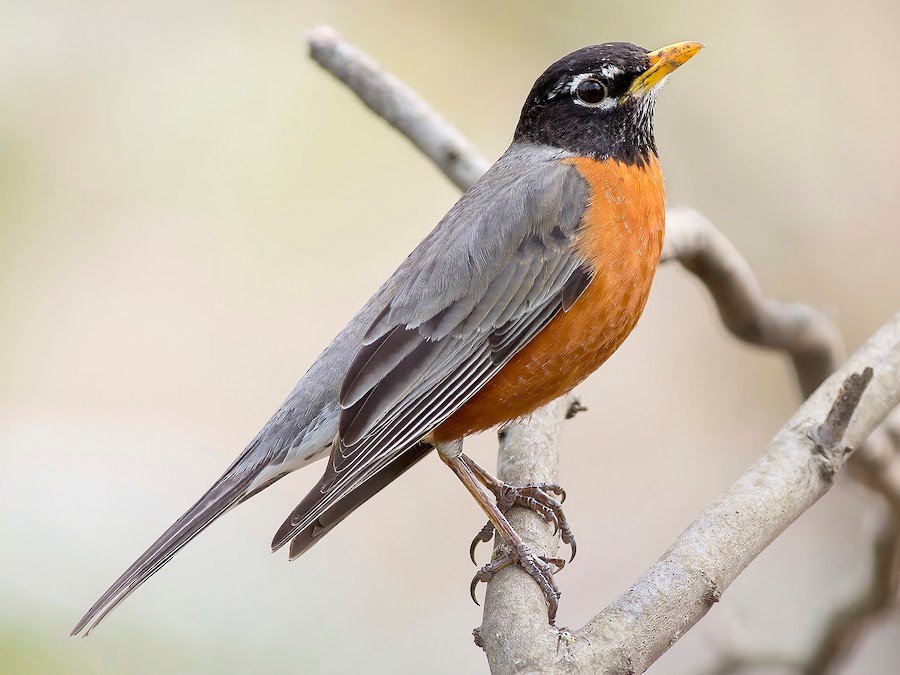
American Robin is a native member of North America and these large birds can be spotted due to their grayish brown color they have grayish brown wings too and the tail is long and the same color. The underside is orange and the rump is white, they have a medium-sized, curved yellow beak and the head is black with a brownish-white eye. When compared with the male, the female has a lighter hue on the heads, than on the back and wings.
The birds have a 9 to 11-inch length, weigh 2.3 to 3.4 ounces and are spotted in a variety of habitats such as forests, gardens, parks and urban places.
They feed on fruits, berries, insects, worms and being highly social, they can be spotted in flocks.
American Crow

American crows are native to North America and these large birds can also be spotted in forests, fields, and urban areas. and throughput from Canada to Mexico and also in the Caribbean. They can be easily identifiable due to their black color and large rounded and short tails. They have a long straight and a top curve beak.
These birds are 17 to 21 inches long, weigh 13 to 21 ounces, and are easily spotted in fields, forests and urban settings.
They feed on insects, fruits, seeds, nuts and human garbage, as they are opportunistic feeders. They build nests in trees and shrubs and being adaptable, they are seen performing complex social behavior.
Gray Jay

Gray Jay is native to North America and it belongs to the crow family. This small bird is also known as the Canada jay and they have dark gray back and gray short wings. They also have long tails, which have white ends and the color is lighter. The underside of the bird is gray and they have a white V shape on top of the breast running down from the face. The bird also has a snowy appearance due to the gray hue which originates from the rear eye. They have short thick and triangle-shaped beaks.
These 9.8 to 11-inch birds weigh 21. to 2. 9 ounces and they are easy to spot in the coniferous forest as they are adapted to the cold and harsh climate.
They feed on a diverse range of food, such as berries, fruits, insects, and even small mammals and bird eggs. They also love pine nuts and save it for the winter days. They build their cup-shaped nest and being highly social are found in pairs or flocks.
Black-headed Grosbeak
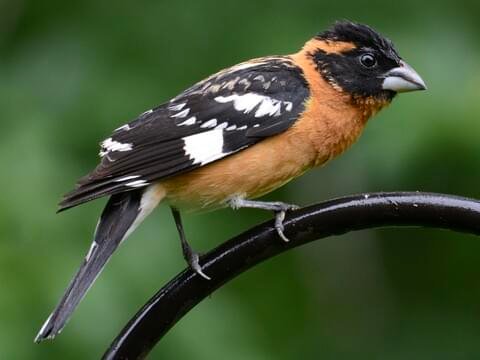
Black-headed Grosbeak can be recognized from their black back, black and white wings, tail and white tip. They also have an orange rump with an orange patch on the underside. They also have black cheeks and a black curved beak. The female Black-headed Grosbeak has brown feathers which makes them easy to spot, along with an orange breast and underbelly.
These birds are 7.5 to 8.7 inches in length and weigh 1.1 to 1.5 ounces. You can spot them in a variety of locations, such as forests, woodlands and riparian trees. The most common place to spot them is oak trees.
They feed on seeds, fruits and insects and are also found to eat nuts, which they store for use when the food becomes scarce. they build their nest in trees or shrubs and are usually found in pairs
Summer Tanager
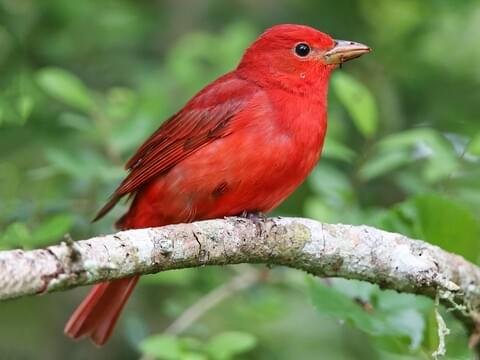
Summer Tanager belongs to the cardinal family and is found majorly in the eastern and central United States, along with Mexico and Central America. It is a medium-sized colorful bird and has bright red wings and a body. It has a black head and tail and can be spotted near forests, woodlands and suburban trees.
They are 7 to 8 inches long and 1.2 to 1.5 ounces in weight. The most common area to spot them is on oak and pine trees. These birds mostly feed on insects and invertebrates, which include beetles, caterpillars and grasshoppers.
They also eat fruits, seeds and berries during the winter. They build their cup-shaped nest and can be found either in solitary or in pairs.
Violet Green Swallow
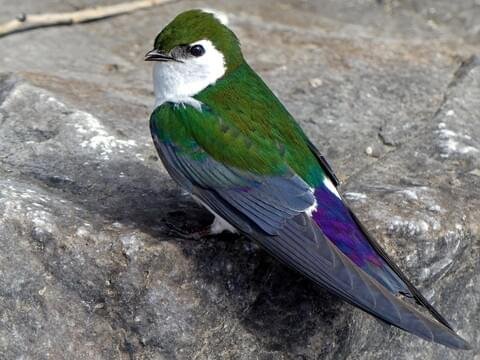
Violet-green swallow is commonly found in North America and they are also spotted across the Western United States and Canada. These small birds can be recognized from their greenbacks and purple shade on their lower back. They have a bronze-colored upper back and wings are long and pointed with a dash of little purple in it. It also has blue and green shades of color on the shoulder and near the stomach and breast of the bird.
It has a beautiful pure white, with a fork-like purple and gray tail. The face is mostly white and in front of the eyes it is gray and you would find that a green cap runs down the nape of the neck. It has a triangular tiny beak and the females are easy to spot as they have grayish-brown head and back.
The birds are slim, 4.7 to 5.9 inches in length and weigh 0.4 to 0.6 ounces. You can find them in open woodland, gardens, parks and most near water bodies. They can adjust to both rural and suburban areas and mostly feed on insects.
Their diet also consists of insects, like beetles, wasps, spiders, flies, etc. They build cup-shaped nests and, being highly social, are found in large flocks.
Anna’s Hummingbird
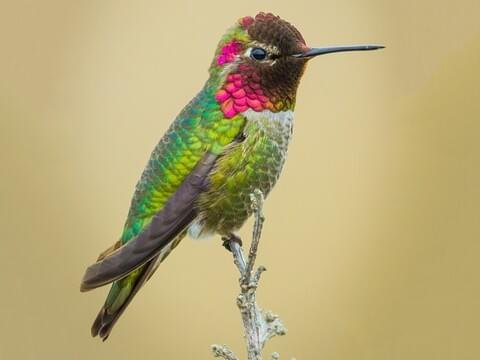
Anna’s Hummingbird is one of the small birds that can be found in North America and it is named after the Duchess of Rivoli, Anna Massena. They can be distinguished from their gray and green backs and they also have yellow above. These birds have a gray color below the wings and the tails are broad and gray along with yellow highlights.
They have a greenish-gray underbelly and the upper side is white and gray. Beneath the cheekbones, they have bright neon pink and at the back of the head and top it is reddish gray. You can also find green, yellow and blue spots on the,. the eyebrow is golden and the beak is long, narrow and straight.
These birds are 3 to 3.5 inches long and 0.1 to 0.2 ounces in weight and they have a very rapid flight style. They have a characteristic long and curved beak to drink nectar. You can easily spot them near desert scrub, forest margins, parks and also residential streets.
They primarily feed on the nectar from the flower, and they also eat insects and spiders. These birds are territorial and aggressive and can be spotted either solitary or in flocks.
Rusty Blackbird
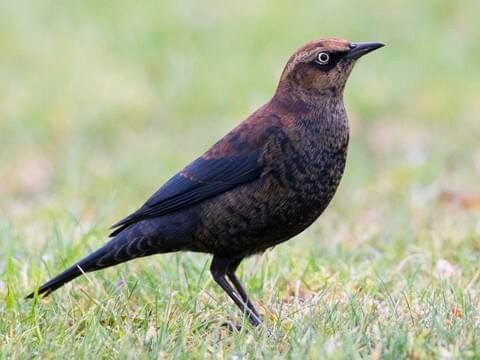
Rusty Blackbird is native to North America and these medium-sized migratory birds can be easily spotted in marshes, swamps and flooded forests. They also occur in the Pacific Northwest and Alaska. They have long thin tails with yellowish eyes and their color changes during the winter.
They have a rusty tint on the upper back and breast and the face has a diamond shape with a black mask. The beaks are long, straight and pointed and the female can be distinguished from males due to their combination of brown and grays.
These 7 to 8.5 inches long birds weigh 0.7 to 1.1 ounces and they feed on insects, spiders, snails, berries and seeds. They build nests using grass and can be found either in flocks or solitary or in pairs, depending on the season.
White Crowned Sparrow

White-crowned sparrows are found in North America and parts of the Western and Central United States. They can also be found in Canada and Mexico. You can easily spot these medium-sized birds in forests, woodlands, grasslands and suburban areas, especially in places with dense vegetation.
These birds can be recognized by their long and dark tails, with dark backs having streaks and two tiny white bars on the wings. It has a white rump, with a brown underbelly which fades into gray. The neck is thick gray and a black eye strip is also visible, with a white crown. It has overall black stripes and the bill is orange and triangular.
The bird is 6 to 7.5 inches in length and weighs 1 to 1.4 ounces and they feed on seeds, fruits and a variety of insects. They build open cup nests on the ground and, being social, these birds can be found in flocks.
Cedar Waxwing

Cedar Waxwing is common in North America and is mostly found in the United States and Canada. These medium-sized birds have light brown backs and gray-colored bottoms. They also have tiny gray wings and brown shoulders with waxy red arranged in vertical lines, which resemble a pipe.
Also, these birds have white lines at the inner terminal of the wings. The tail is gray and short, along with yellow ends, an underside and a white rump. The top part is brown, along with the face. The interesting feature is that it has an up-curve black mask and a hint of color on either side of the eye.
They are 6 to 7 inches in length, weigh 0.9 to 1.2 ounces and are majorly spotted near forests, woodlands, suburban areas and fruit-bearing trees.
They feed on fruit insects and their favorite is cedar berries. These birds are also highly social and are found in large flocks.
Brown Creeper
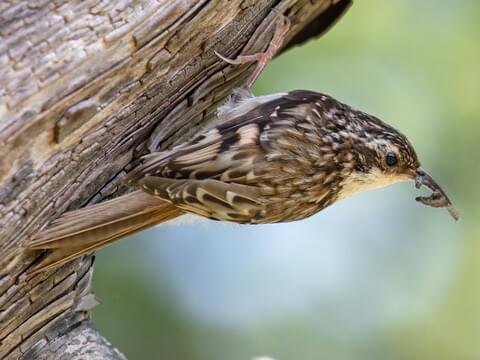
Brown Creeper is found in North America and they can be spotted due to the black and white stripes that cover the wings. on the underside and breast, they have a creamy tan border and there are also long, thin, white streaks on the tails. The upper side is brown with white stripes and the eyes have a buffy strip. They have long, curved and black-yellowish bills.
These birds are 4.5 to 5.5 inches long and they weigh 0.3 to 0.5 ounces, having a weak fluttering flight style.
They feed on insects, and spiders and use their long curved beak to catch the prey. They build nests in tree cavities and are usually found solitary on tree trunks.
Black-capped Chickadee
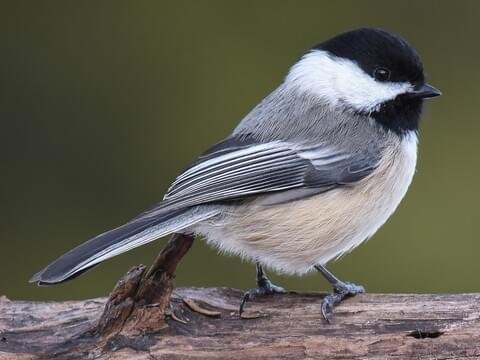
Black-capped Chickadee is also a native of North America; these small birds are gray with short wings and a white border running down the feather. They have long tails and white outer feathers, with white underside. They have a huge black cap and a black bib. They have tiny, small and trapezoidal beaks.
These birds are 4.5 to 6 inches long, weigh 0.35 to 0.6 ounces and are spotted in marshes, shrubs and fields.
These birds are omnivores and are seen to feed on both plants and animals, but their favorite is seeds, berries and a variety of insects, such as beetles, aphids, caterpillars, etc. These birds are quite sociable and so seen in small flocks.
Which is The Most Common Bird Spotted in Washington State?
The most common bird to be spotted in Washington State is the House sparrow which is found most near grassy areas.
Where Can You Find a Detailed Source of All Birds of Washington State?
You can find every detail of all the bird species living in Washington State, through the Washington Ornithological Society or the Washington Bird Records Committee.
Which Bird is Called Washington’s State Bird?
The American goldfinch has been known to be Washington’s state bird since 1928. These birds can be seen throughout Washington State and all year long.

